#antoine duhamel
Photo
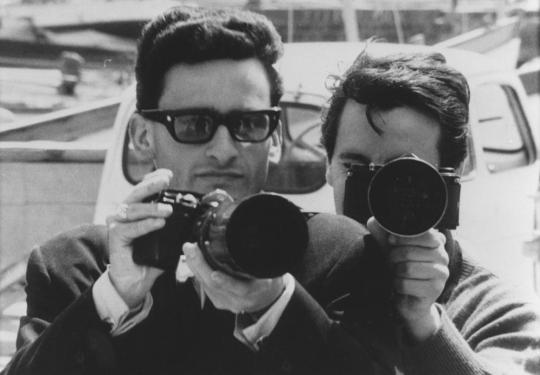
Paparazzi, Jacques Rozier (1964)
#Jacques Rozier#Michel Piccoli#Jean Lescot#David Tonelli#Brigitte Bardot#Jean Luc Godard#Maurice Perrimond#Antoine Duhamel#1964
2 notes
·
View notes
Text
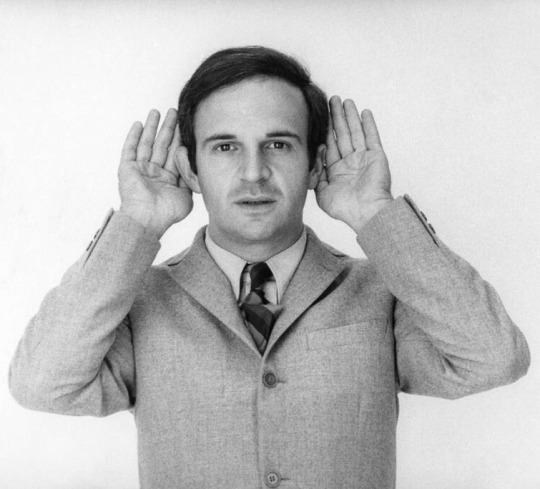
Music from the films of François Truffaut
· playlist
Jean Constantin, Georges Delerue, Bernard Herrmann, Antoine Duhamel, Maurice Jaubert, etc.
#François Truffaut#Film Music#georges delerue#bernard herrmann#antoine duhamel#Maurice Jaubert#Jean Constantin
1 note
·
View note
Photo

Bande Originale Du Feuilleton Télévisé "BELPHEGOR" ( 1968 ).
0 notes
Text
The Antoine Doinel Cycle

Jean-Pierre Léaud in The 400 Blows (François Truffaut, 1959)
Cast: Jean-Pierre Léaud, Albert Rémy, Claire Maurier, Patrick Auffay, Georges Flamant. Screenplay: François Truffaut, Marcel Moussy. Cinematography: Henri Decaë. Film editing: Marie-Josèphe Yoyotte. Music: Jean Constantin.
One of the unquestioned great movies, and one of the greatest feature-film directing debuts, The 400 Blows would still resonate with film-lovers even if François Truffaut hadn't gone on to create four sequels tracking the life and loves of his protagonist, Antoine Doinel (Jean-Pierre Léaud). There are, in fact, those who think that the last we should have seen of Antoine was the haunting freeze-frame at the end of the film. But Antoine continued to grow up on screen, and perhaps more remarkably, so did Léaud, carving out his own career after his debut as a 13-year-old. (It's hard to think of any American child actors who were able to maintain a film career into adulthood as well as Léaud did. Mickey Rooney? Dean Stockwell? Who else?) Having Truffaut as a mentor certainly helped, but Léaud had an unmistakable gift. He is on screen for virtually all of the 99-minute run time, and provides a gallery of memorable moments: Antoine in the amusement-park centrifuge, Antoine in the police lockup, Antoine on the run -- in cinematographer Henri Decaë's brilliant long tracking shot. And my personal favorite moment: when the psychologist asks Antoine if he's ever had sex. Léaud responds with a beautiful mixture of surprise, amusement, and embarrassment. It's so genuine a response that I have to think it was improvised, that Truffaut surprised Léaud with the question. But even so, Léaud never drops character in his response. This praise of Léaud is not to undervalue the magnificent supporting cast, or the haunting score by Jean Constantin. It's a film in which everything works.

Jean-Pierre Léaud and Marie-France Pisier in Antoine and Colette (François Truffaut, 1962)
Cast: Jean-Pierre Léaud, Marie-France Pisier, Rosy Varte, François Darbon, Patrick Auffay, Jean-François Adam. Screenplay: François Truffaut. Cinematography: Raul Coutard. Music: Georges Delerue.
Four years after he made The 400 Blows, Truffaut was asked to contribute to an anthology of short films by directors from various countries to be called Love at Twenty. As he had with the first film, Truffaut drew on his own experience, an infatuation with a girl he had met at the Cinémathèque Française. And since Léaud was available -- he had worked with Julien Duvivier on Boulevard (1960) after completing The 400 Blows -- it made sense for him to play Antoine Doinel again. A narrator tells us that Antoine had been sent to another reform school after escaping from the first, and that this time he had responded well to a psychologist: After leaving school, he has found a job working for the Phillips record company and is living on his own. Then he sees a pretty young woman at a concert of music by Berlioz and falls for her. Colette (Marie-France Pisier) is not much interested in him, but she is evidently flattered by his advances. Her parents like Antoine and encourage him so much that he rents a room across the street from them. (Truffaut had done the same thing during his crush.) But one evening when he comes to dinner at their apartment, a man named Albert (Jean-François Adam) calls on Colette and she leaves Antoine watching TV with her parents. It's a droll little film, scarcely more than an anecdote, and the stable, lovestruck Antoine doesn't seem much like either the rebellious Antoine of the first film or the more scattered Antoine of the later ones in the cycle.
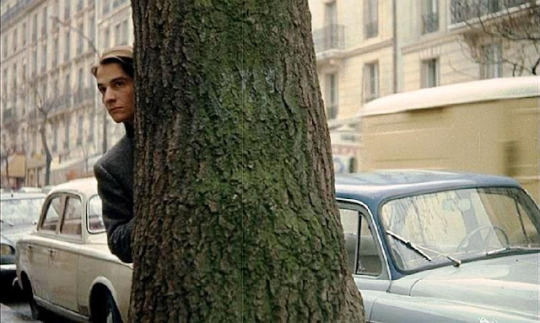
Jean-Pierre Léaud in Stolen Kisses (François Truffaut, 1968)
Cast: Jean-Pierre Léaud, Claude Jade, Michael Lonsdale, Delphine Seyrig, Michael Lonsdale, Claire Duhamel, Daniel Ceccaldi. Screenplay: François Truffaut, Claude de Givray, Bernard Revon. Cinematography: Denys Clerval. Production design: Claude Pignot. Film editing: Agnès Guillemot. Music: Antoine Duhamel.
The Antoine of Stolen Kisses is in his 20s, but has reverted to the more haphazard ways of his adolescence: He has been kicked out of the army, and now relies on a series of odd jobs to get by. But he has also renewed acquaintance with a young woman he met before going into the army, Christine Darbon (Claude Jade). Like Colette's parents, hers are quite taken with Antoine, and they help him get a job as a night clerk in a hotel. He gets fired from that job after helping a private detective who is spying on an adulterous couple, but the detective helps Antoine get a job with his agency. While working for the detective agency, he has to pose as a clerk in a shoe store, and winds up in a liaison with the store owner's wife, Fabienne (Delphine Seyrig). When that ends badly, he becomes a TV repairman, which brings him back to Christine, with whom he winds up in bed after trying to fix her TV. At the film's end, a strange man who has been following Christine comes up to her and Antoine in the park and declares his love for her. She says he must be crazy, and Antoine, who perhaps recognizes his earlier infatuation with Colette in the man's obsession, murmurs, "He must be." Stolen Kisses is the loosest, funniest entry in the cycle, though it was made at a time when Truffaut was politically preoccupied: The film opens with a shot of the shuttered gates of the Cinémathèque Française, which was shut down in a conflict between its director, Henri Langlois, and culture minister André Malraux. This caused an uproar involving many of the directors of the French New Wave. Some of Antoine's anarchic approach to life may have been inspired by the rebelliousness toward the establishment prevalent in the film community. But it's clear that the idea of a cycle of Antoine Doinel films has been brewing in Truffaut's mind: There is a cameo appearance by Marie-France Pisier as Colette and Jean-François Adam as Albert, now married and the parents of an infant.

Claude Jade and Jean-Pierre Léaud in Bed and Board (François Truffaut, 1970)
Cast: Jean-Pierre Léaud, Claude Jade, Claire Duhamel, Daniel Ceccaldi, Hiroko Berghauer. : François Truffaut, Claude de Givray, Bernard Revon. Cinematography: Néstor Almendros. Production design: Jean Mandaroux. Film editing: Agnès Guillemot. Music: Antoine Duhamel.
Antoine and Christine have married, and they have settled down in a small apartment. (There's some indication that it's paid for by her parents.) She gives violin lessons and he sells flowers -- carnations, which he dyes, using some environmentally questionable potions. But settling down isn't in Antoine's nature, and when Christine gets pregnant he looks for more lucrative work. He finds a curious sinecure in a company run by an American: Antoine maneuvers model ships by remote control through a mockup of a harbor. ("It gives me time to think," he says.) One day, a Japanese businessman comes to see the demonstration, accompanied by a pretty translator named Kyoko (Hiroko Berghauer), and Antoine is soon involved in an affair with her. Naturally, this precipitates a breakup, though by film's end they have seemingly reconciled. Still, it's obvious that the marriage is not destined to be permanent. They can't even agree on a name for their son: She wants him to be called Ghislain, and he wants to call him Alphonse. Antoine wins out by a trick: He's the one who goes to the registry office to legalize the boy's name. Antoine also spends time writing a novel about his boyhood, to which Christine objects: "I don't like this business of writing about your childhood, dragging your parents through the mud. I don't know much but I do know one thing: If you use art to settle accounts, it's no longer art." Truffaut had his own regrets about the portrait of his parents in The 400 Blows. Less farcical than Stolen Kisses, Bed and Board still has a strong vein of comedy tinged with melancholy.
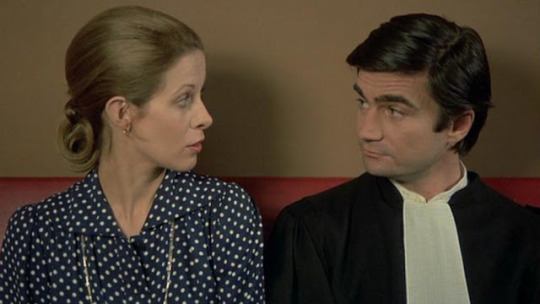
Claude Jade and Jean-Pierre Léaud in Love on the Run (François Truffaut, 1979)
Cast: Jean-Pierre Léaud, Marie-France Pisier, Claude Jade, Dani, Dorothée, Daniel Mesguich, Julien Bertheau. Screenplay: François Truffaut, Marie-France Pisier, Jean Aurel, Suzanne Schiffman. Cinematography: Néstor Almendros. Production design: Jean-Pierre Kohut-Svelko. Film editing: Martine Barraqué. Music: Georges Delerue.
Truffaut admitted that he wasn't happy with the final film in the cycle. It's a bit too heavily reliant on flashback clips from the four earlier films, and if it's intended to show that Antoine has finally stabilized now that he's in his 30s and divorced from Christine, it doesn't quite make the case. He has a new girlfriend, Sabine (Dorothée), his novel has been published several years earlier, and he works as a proofreader for a printing house. He's on friendly terms with Christine, and agrees to take their son, Alphonse, to the train station when the boy leaves for a summer music camp. At the station, he runs into Colette, now a defense lawyer, who is on her way to confer with a client -- a man who has murdered his 3-year-old boy. Perhaps a little too coincidentally, Colette is involved with Sabine's brother, Xavier (Daniel Mesguich), and she has bought a copy of Antoine's novel to read on the train. Antoine impulsively boards the train, and sets up a meeting with Colette in the dining car, after which she invites him back to her compartment. All of this sets up a series of revelations: Colette's marriage to Albert broke up after their small daughter was killed by a car. She claims that she supplements her small income as a lawyer by prostituting herself with men she meets on trains. Antoine finally made peace with his mother after her death when he met her old lover, M. Lucien (Julien Bertheau), who persuaded him to visit his mother's grave. (There is a flashback to the scene in The 400 Blows when Antoine, playing hooky, sees his mother kissing a strange man on the street.) Antoine became infatuated with Sabine after hearing a man in a phone booth arguing with a woman on the other end of the line and then tearing up her photograph. Antoine picked up the pieces from the floor, put them together, and after some sleuthing, discovered the woman was Sabine. His marriage to Christine finally broke up after he slept with her friend Liliane (Dani), who he previously had thought was having a lesbian relationship with Christine. And so on. The result of all the flashbacks and revelations is not to round out the Antoine Doinel saga, but to make Love on the Run feel over-contrived.
#The 400 Blows#Jean-Pierre Léaud#Marie-France Pisier#François Truffaut#Antoine and Colette#Stolen Kisses#Bed and Board#Claude Jade#Love on the Run
15 notes
·
View notes
Video
dailymotion
Godard a révolutionné le cinéma par l’image mais aussi par le son. Il commandait des œuvres originales à des compositeurs, qu’il aimait re-composer et modifier lui-même ensuite...ainsi, si les compositeurs apparaissent aux génériques, Jean-Luc Godard a aussi eu une grande influence sur la musique de ses films, qu’il s’appropriait.
L’une de ses plus célèbres bande-originales est celle du Mépris, le "Thème de Camille" par Georges Delerue. D’après Stéphane Lerouge, Godard s’agaçait même du succès de ce thème, dont les réutilisations ont largement dépassé le cadre de son film.
Godard s’est associé à des compositeurs tels que Martial Solal, Antoine Duhamel, Michel Legrand ou Georges Delerue, mais ces collaborations n’ont pas été récurrentes comme celles d’autres duos réalisateur-compositeur.
(via Vivre sa vie en musique avec Jean-Luc Godard)
8 notes
·
View notes
Text

Frances Ha (2012, Noah Baumbach)
15/12/2023
Frances Ha is a 2012 film directed by Noah Baumbach and written by Baumbach and Greta Gerwig, who is also the protagonist. The film premiered at the Telluride Film Festival in September 2012 and was released internationally in 2013.
Frances Halladay is a 27-year-old aspiring dancer who lives with her best friend Sophie in Brooklyn. Frances refuses to leave Sophie, but she is not reciprocated, as her friend, immediately after her, tells her that she will be moving to a loft in Tribeca, making the big leap from Brooklyn to Manhattan.
Frances finds a new apartment with new roommates. Happy with her new life, Frances runs down the street to the tune of David Bowie's Modern Love. Unable to pay the rent, she returns to her parents on the outskirts of Sacramento, where she spends a Christmas with her family, seeing her college friends.
Depression and a sense of abandonment can be seen, after so many celebrations, in the desperate expression with which he takes the plane back to New York.
She takes a temporary job as a student assistant at his old college and settles into a sad dorm in Poughkeepsie.
The film ends with the presentation of his very successful choreography and the beginning of a new life in his new apartment in Washington Heights.
The filmmakers included a number of pop songs, including Hot Chocolate's Every 1's a Winner, The Rolling Stones' Rocks Off, Paul McCartney's Blue Sway, T. Rex's Chrome Sitar and David Bowie's Modern Love: the latter sequence is a tribute to Leos Carax's film, Mauvais Sang, where Denis Lavant runs through the streets like Greta Gerwig, with the same soundtrack. The musical choice is also a tribute to various Nouvelle Vague films with music by Georges Delerue, Jean Constantin, Antoine Duhamel and a song by Felix Laband.
Based on 136 reviews collected by the aggregation site Rotten Tomatoes, the film receives a 93% "Certified Fresh" approval rating, with an average score of 7.9/10. Metacritic gives an average score of 82/100, indicating "universal acclaim" based on 35 reviews.
#frances ha#film#2012#noah baumbach#greta gerwig#Telluride Film Festival#brooklyn#loft#tribeca#manhattan#modern love#david bowie#sacramento california#new york city#Poughkeepsie New York#Washington Heights Manhattan#hot chocolate#the rolling stones#paul mccartney#t rex#leos carax#mauvais sang#denis lavant#french new wave#Georges Delerue#Jean Constantin#Antoine Duhamel#Felix Laband#rotten tomatoes#metacritic
1 note
·
View note
Text



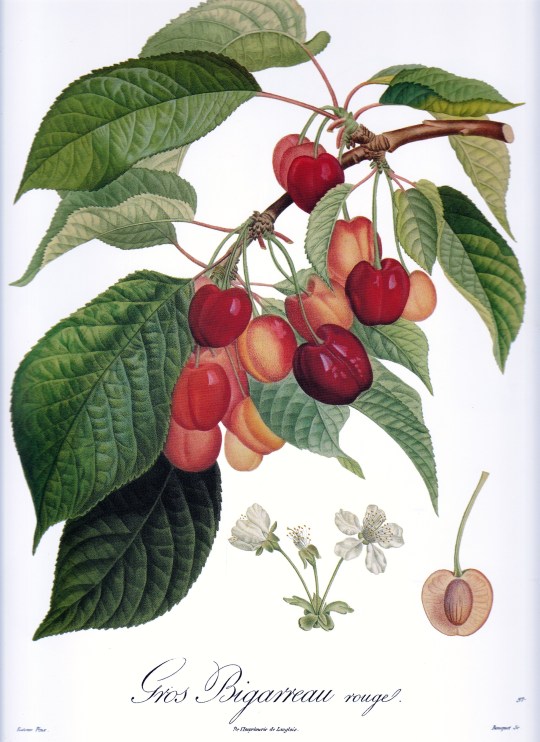


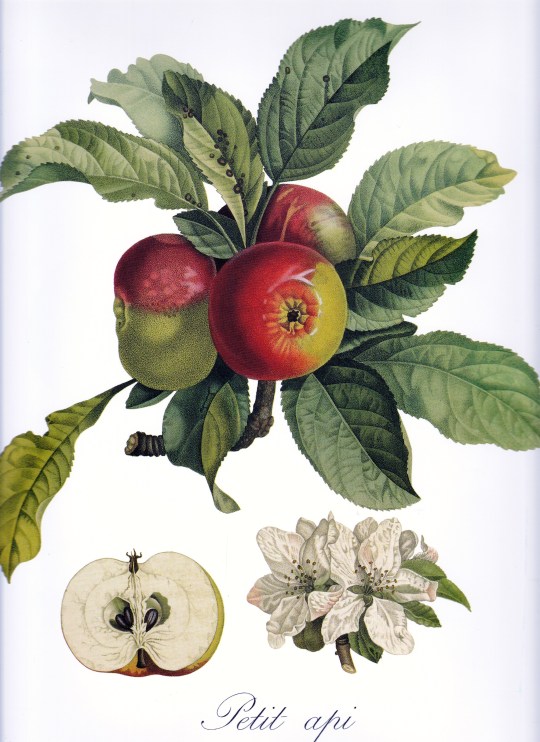

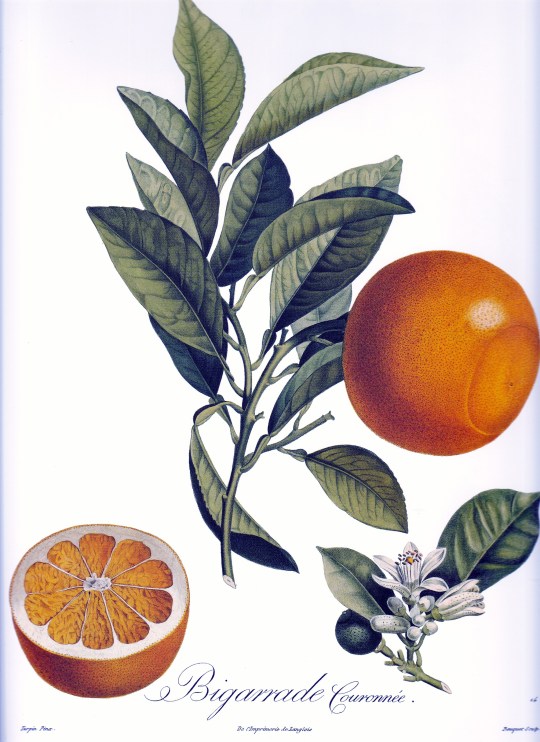
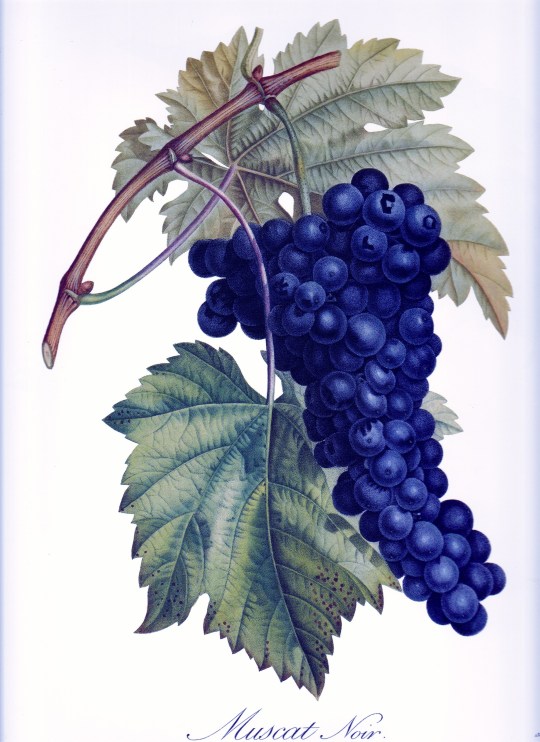

Les fruits de Poiteau et Turpin
Jean Salette
Editions Langlaude, Lamorlaye 2011, 88 pages, 27.7x33.7cm, ISBN 978-2915677409
euro 25,00
email if you want to buy [email protected]
Au milieu du XVIIIe siècle, le développement des connaissances crée de véritables disciplines scientifiques, activités concomitantes de l'émergence de l'esprit encyclopédique qui veut faire des sommes de tous les savoirs. Cette effervescence engendre un des évènements les plus importants de l'histoire européenne, l'Encyclopédie de Diderot et d'Alembert. C'est dans ce contexte que paraît en 1768 le Traité des arbres fruitiers de Henri-Louis Duhamel du Monceau. En 1806, l'éditeur Michel en entreprend la réédition et fait appel à deux botanistes et dessinateurs de renom, Antoine Poiteau et Pierre Turpin. Outre l'aspect scientifique, la nouveauté et l'intérêt résident dans le nouveau procédé de mise en couleurs des lithographies mis au point par Pierre-Joseph Redouté. Chaque épreuve, tirée par un seul passage, est ensuite retouchée à la main afin d'obtenir tout le brillant et tout le moelleux de l'aquarelle. Cet ouvrage, le premier sur Pierre Turpin et Antoine Poiteau, nous invite à admirer la beauté et la fidélité des Illustrations.
13/12/23
0 notes
Photo


Affiche pour le festival Agraphe / 2nde édition !
Typographie et illustration Antoine Bréda
Mise en page et gestion de la page instagram, création de réels Olivia Duhamel
0 notes
Video
Swissquote Happy 25th from Simon Duhamel on Vimeo.
If today’s investors no longer look like those 25 years ago, it’s also because of you.
Happy birthday!
Director - Simon Duhamel
Executive Producer - Carolan Grégoire
Producer - Smith
Production Manager - Nick Fontaine
Production Manager - Nicolas Gonos
Coordo - Lola-Lou Fergeau-Mariko
1st AD - Jonathan Jean-Pierre
2nd AD- Natalia Grijalva
Camera
DOP + Photographer - Simon Duhamel
1st AC - Christophe Sauvé
2nd AC - William Tétreault
DIT - Jacob Soulard
Digital Tech - Renaud Robert
Light Assist - Renaud Lafrenière
BTS Photographe - Anabel Boivin
Electro
Gaffer - Hugo Ferland Dionne
Best Boy Electro - Olivier Racine
3rd Electro - Kyle Pelletier
4th Electro - Kevin Bellegarde
Grip
Key Grip - Samuel Labarre
Best Boy Grip - Pierre-Luc Schetagne
3rd Grip - Olivier Arends Leblanc
4th Grip - Virgile Rattelle
Swing - Edouard Sauvage
Art Department
Art Director - Louisa Schabas
Ass. Art Director - Joao Baptista
Ass. Art Director - Maria Rainha
Swing - Nicolas Privé
Props Buyer - Christina Vincelli
Set Dresser - Kate Ray Struthers
Swing Gang 1 - Gabriel Monette
Swing Gang 1 - Antoine St-Germain
Props Master - Carl Pepin
Coordo - Melanie May Taillon
Vanities
Wardrobe Stylist - Andrée-Jade Hélie
Stylist Asst. - Bianca Roussel-Marino
Hair Stylist - Laurie Deraps
MU Artist - Tania Guarnaccia
Unit
Covid Coordinator - Robin Maurais
PA - Sofian Derdouri
PA - Étienne Brisson
Post-Production (Photo)
Retoucheuse - Pénélope St-Cyr Robitaille
Post-Production (Vidéo)
Postproduction image - OUTPOST MTL
Directeur général - Bertrand Paquette
Coordonnatrice de postproduction - Gabrielle St-Onge
Coloriste - Martin Gaumond
Monteur en ligne - Simon Allard
Assistante à la postproduction - Amélie Santerre
Producteur VFX - Evren Boisjoli
VFX - PIXEL PERFECT
Superviseur VFX - Rene Allegretti
Superviseur Comp - Eden Munoz
Chargée de projet - Paola Pitalua
Artiste CG - Ricardo Santillana
Artiste CG - Ana Luisa Lopez
Directeur technique FX - Diego Lozano
Compositing - Carlos de la Garza
Compositing (junior) - Chava Monroy
Pre-Production
Storyboarder - Jocelyn Bonnier
Talents
Modèle - Jordan Faye
Modèle - Claudine De Repentigny
Modèle - Pierre-Paul Côté
Modèle - Alex Mackenzie
Modèle - Linda Vandal
Modèle - Attila Hosvépian
VO - EN - Amy Trowell
VO - DE (CH) - Kathrin FG
VO - FR - Vanessa Bettane
VO - IT - Laura Devoti
VO - AR - Nada Kibbe
VO-ESP - Maria Cristina Nastrangeli
Swissquote
Brand Manager - Alain Greter
Head Marketing - Romain Le Baud
Head Brand Creation & Marketing Development - Jose Rosa
Chief Sales and Marketing Officer- Jann De Schepper
Cavalcade
Creative Director - David von Ritter
Art Director - Julien De Preux
Art Director - Maxime Merchez
Graphic Designer - Camille Natalini
Client Director - Nina Hugentobler
Account Manager - Katia Lallar
Assistant Account Manager - Patricia Azevedo
1 note
·
View note
Photo
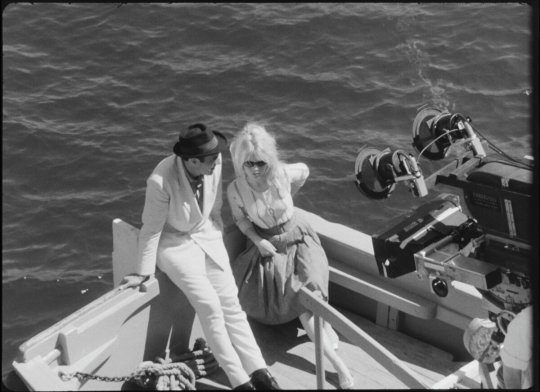
Le Parti des choses: Bardot et Godard, Jacques Rozier (1964)
2 notes
·
View notes
Text
15 au 21 août 2022
Monday was a holiday, however, I worked so I could have Friday off instead. I watered most of the day. I started collecting seeds too, just in case the rains do come. Storms are forecast for the end of the week, however, I don’t trust they will come so I’m watering as usual. Things died over the weekend, which is very strange.
I worked half day Tuesday so I could head to Monaco for lunch. Dianne, Ken and Chris are on a cruise and they moored in Monaco today. Thankfully Dianne and Ken were released from Covid quarantine yesterday. Chris is still in quarantine, sadly. We enjoyed a nice lunch together then we took the hike up the hill, with a great view over the port. It was sweltering. This was the first exercise Dianne and Ken had been able to do since they went into quarantine five days ago. We slowly made our way back to the ship and said our goodbyes.

Then by chance Caitlin had arrived in the morning, so I headed over to meet her at her yacht. She only had about an hour so we made a beeline for ice cream. It was really fun to see her and to have a catch up.

Wednesday the storm clouds were gathering so I only watered the big pots and anything that I know is in a rain shadow. I was hedging my bets. Then I removed a very large Echium candicans that had sadly died in the heat this year. It was a beautiful specimen. I planted two smaller ones in its place and added an E. purpurea and E. simplex that I grew from seed from CPG.

Couli is drying a sunflower head in the glasshouse; it is so interesting to look at up close.
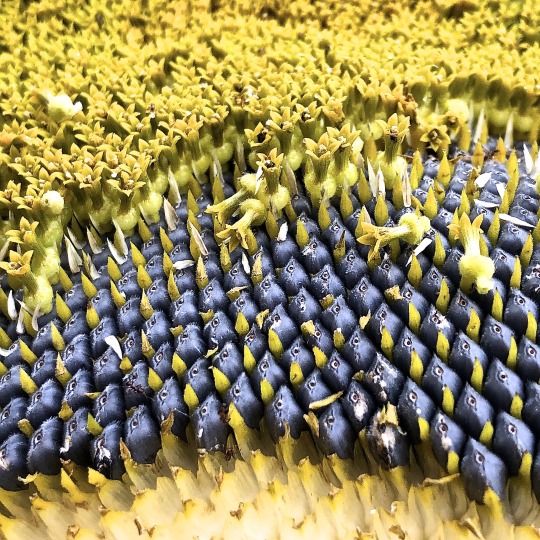
The rain finally arrived and it continued on and off all afternoon.
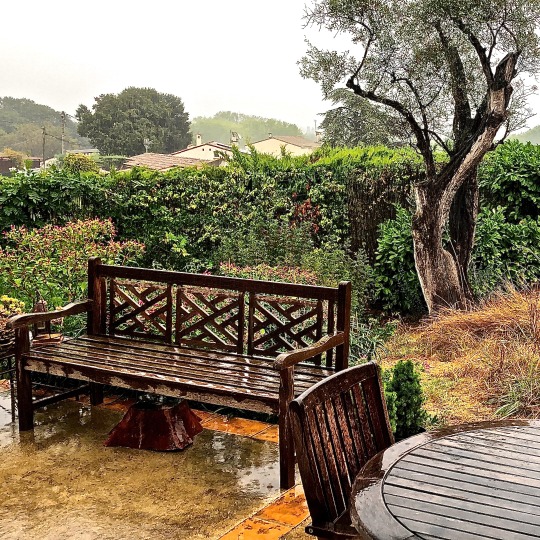
Thursday was a very wet morning. There was amazing lighting overnight. I’m looking forward to seeing how the plants respond. We had a good welcome Zoom call for the Quinta and Ismael was there. It was good to see him after almost a year. I collected Denis at the airport then we headed to his for dinner. I spent the night for my 06.54 train to Rome Friday morning.
I took the train to Rome on Friday; it is a seven hour journey. Lucien arrived at the hotel around 19.00. We met up with a friend of his at a nice restaurant, Antica Trattoria Angelino, hidden away near Il Vittoriano. Saturday morning I hired a tandem then had my necessary Covid test. Lucien and I rode the tandem south of the city around 12 kilometres. It was tough going and the chain came off three or four times; nonetheless, it was a great day out and we had an amazing coffee. That evening we found a restaurant just near the hotel. We were both very sore and tired.
Sunday morning Jody and Steve picked us up with their transfer to ship at 10.45. We set sail Sunday evening at 17.00. The Odyssey of the Seas is gigantic, yet, the interior is quite cosy. Unfortunately there was a constant battle of the bands everywhere on the ship.
Plant of the week
Pinaceae Pinus halepensis Mill.
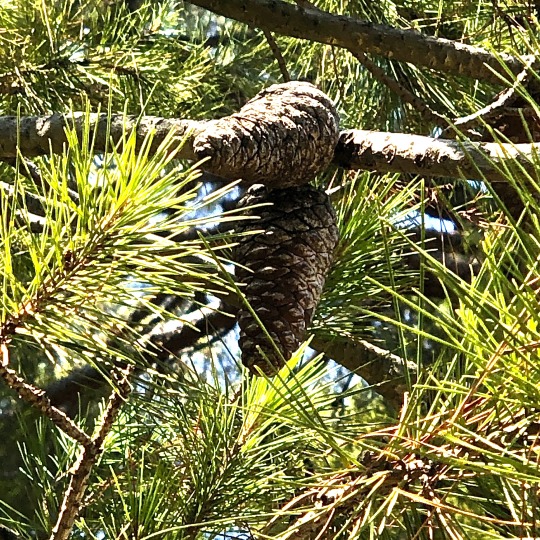
common name(s) - Aleppo pine
synonym(s) - Pinus abasica Carrière; P. abchasica Carrière; P. arabica Sieber ex Spreng.; P. carica D.Don; P. ceciliae Llorens & L.Llorens; P. colchica Booth ex Gordon & Glend.; P. genuensis J.Cook; P. halepensis var. abasica (Carrière) Carrière; P. halepensis var. carica (D.Don) Carrière; P. halepensis var. ceciliae (Llorens & L.Llorens) L.Llorens ex Rosselló, Cubas & N.Torres; P. halepensis subsp. ceciliae (Llorens & L.Llorens) Silba; P. halepensis var. genuensis (J.Cook) Antoine; P. halepensis var. minor Antoine; P. halepensis var. pendula P.P.Ferrer & R.Ferrer; P. hierosolimitana Duhamel; P. hispanica J.Cook; P. loiseleuriana Carrière; P. maritima Aiton; P. maritima Mill.; P. paroliniana Webb ex Carrière; P. parolinii Vis.; P. penicillus Lapeyr.; P. pseudohalepensis Denhardt ex Carrière; P. saportae Rouy
conservation rating - Least Concern
native to - Mediterranean
location - Domaine de l’Orangerie
leaves - needle-like, in bundles of two, blade 40 to 80mm long, slender and stiff, grey-green to yellowish green
fruit - cones, conic-ovoid, 80 to 100mm long, clustered on stout, reflexed stalks; scales flat or slightly raised along a transverse ridge; ripen to brown and may remain on the tree for years; open slowly over a few years, a process quickened if they are exposed to heat such as in forest fires; seeds are wind-dispersed
habit - coniferous tree, up to 20m high, 8m wide, conical with an open crown; trunk short when young, crooked when older; bark silvery grey becoming becoming reddish-brown and deeply fissured
habitat - mesic grassland, Zastron moist grassland, grassland, shrubland, from sea level to 1,700m
pests - adelgids, aphids, sawfly larvae, pine shoot moth
disease - pine needle cast
hardiness - to -15ºC (H5)
soil - well-drained, most soil types
sun - full sun
propagation - seed
pruning - none required
nomenclature - Pinaceae - Pinus - the ancient Latin name for a cone-bearing tree, pine (cognate with pineus, piñon and pine[-apple]; halepensis - from Aleppo (Halab) northern Syria
NB - able to quickly colonize open and disturbed areas; is classed as an invasive species in South Africa; can grow on all substrates and almost in all bioclimates in the Mediterranean; resin of the Aleppo pine is used to flavor the Greek wine retsina; from the pine nuts of the Aleppo pine is made a pudding called asidet zgougou in the Tunisian dialect; it is served in bowls, covered with cream, and topped with almonds and small candies; the Maltese dessert prinjolata is also prepared using these pine nuts, both in its filling as well as a topping; Aleppo pine are used for bonsai; Paul Cézanne had an Aleppo pine in his garden at Aix-en-Provence; this tree was the inspiration and model for his painting The Big Trees, and as of 2005, the tree was still growing in Cézanne's garden.
References :
CABI [online] https://www.cabi.org/isc/datasheet/41617 [17 Aug 22]
EUFORGEN (European Forest Genetic Resources Programme) [online] https://www.euforgen.org/species/pinus-halepensis/ [17 Aug 22]
Gledhill, David, (2008) “The Names of Plants”, fourth edition; Cambridge University Press; ISBN: 978-0-52168-553-5
IUCN [online] https://www.iucnredlist.org/species/42366/2975569 [17 Aug 22]
Mistral Bonsai [online] https://www.mistralbonsai.com/en/all-about-bonsai/bonsai-datasheets/mediterranean-bonsai/pinus-halepensis/ [17 Aug 22]
Plants of the World [online] https://powo.science.kew.org/taxon/urn:lsid:ipni.org:names:262982-1 [17 Aug 22]
Royal Horticultural Society [online] https://www.rhs.org.uk/plants/13085/i-pinus-halepensis-i/details [17 Aug 22]
Wikipedia [online] https://en.wikipedia.org/wiki/Pinus_halepensis [17 Aug 22]
World Flora Online [online] http://www.worldfloraonline.org/taxon/wfo-0000481363 [17 Aug 22]
0 notes
Video
youtube
Antoine Duhamel • thème de Ferdinand, Pierrot le Fou (dir. Jean-Luc Godard, 1965)
11 notes
·
View notes
Text
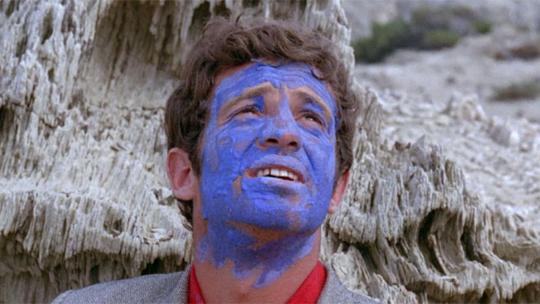
Jean-Paul Belmondo in Pierrot le Fou (Jean-Luc Godard, 1965)
Cast: Jean-Paul Belmondo, Anna Karina, Graziella Galvani. Screenplay: Jean-Luc Godard, Rémo Forlani, based on a novel by Lionel White. Cinematography: Raoul Coutard. Production design: Pierre Guffroy. Film editing: Françoise Collin, Music: Antoine Duhamel.
Roger Ebert gave Pierrot le Fou three and a half stars when he reviewed it in 1966, lauding Jean-Luc Godard's "virtuoso display of his mastery of Hollywood genres." But in 2007, reviewing a re-release of the film, he reduced the assessment to two and a half stars: "I now see it," he wrote, "as the story of silly characters who have seen too many Hollywood movies." I think my opinion of the film might have been the reverse of Ebert's: If I had seen it when I was in my snooty 20s, I might have dismissed it as a pretentious and arty example of the French New Wave at its worst, mixing silly antics with facile social and political satire. Instead, it now strikes me as a brilliant deconstruction of Hollywood film noir, gangster movies, and romantic adventure, almost perverse in its opening up of the traditional claustrophobic black-and-white atmosphere of noir with its bright wide-screen Eastmancolor images. And without Pierrot le Fou, or other Godard films like Breathless (1960) or Bande à Part (1964), would Hollywood have had the inspiration or the nerve to make movies like Bonnie and Clyde (Arthur Penn, 1967)? Yes, the characters played by Jean-Paul Belmondo and Anna Karina are silly, but Godard makes us see through their eyes the absurdity of the commerce-ridden milieu in which they exist. There is no core to their lives, no matter how much Ferdinand (Belmondo) and Marianne (Karina) may try to establish one with art and literature on his part or with a pursuit of fun on hers. The French have always loved to épater le bourgeoisie, and Godard plants himself firmly in that tradition, but the absurdity of Ferdinand's self-immolation (or -detonation), painting his face blue and wrapping his head in explosives, suggests that there is a price to be paid for shaking up the squares. But until we reach that point, Allons-y, Alonso!
0 notes
Text
Edit: On the Trail of La Bete du Gevaudan
Edit: On the Trail of La Bete du Gevaudan. - The script for this week's podcast needed a LOT of editing, so ... here we go.
A slumber did my spirit seal; I had no human fears: She seemed a thing which could not feel The touch of Earthly years. No motion has she now, no force; She neither hears nor sees; Rolled round in Earth’s diurnal course, With rocks, and stones, and trees. William Wordsworth ‘A Slumber did my Spirit Seal’ – 1800.
While going through scripts for the podcast it occurred to me this episode needed a…

View On WordPress
#18th Century#Beast of Gedauvan#Francoise Antoine#French History#Gedauvan#Hyena#Jacques Portefaix#Jean Chastel#Jean-Baptiste Duhamel#Jeanne Boulet#La Bete Du Gedauvan#Lion#Louis VX#Marie Jeane Valet#Mesonychid#Seven Years War#Silver bullet#Werewolf#Werewolves
2 notes
·
View notes
Photo


La Bête du Gévaudan [French mythology]
This one isn’t technically a mythical creature, but whatever it was, I doubt it was a werewolf or magical beast like some stories claim. So I say it counts.
Between 1764 and 1767, the French province of Gévaudan was terrorized by a series of attacks from a strange monster – appropriately named la Bête du Gévaudan, or ‘The beast of Gévaudan’. Eyewitnesses claimed that the creature looked like a very large wolf with an immense tail. The exact amount of attacks is not known, but estimated to be over 600. The estimated number of victims ranges between 60 and 500 human deaths. As such, the French government – by command of Louis XV – offered a significant reward to whoever managed to slay the monster (as no Witcher was available).
Captain Duhamel readied his dragoons (mounted soldiers) and rode to Gévaudan, where he encountered and almost killed the beast, but it managed to escape. He organized wolf-hunting parties, but his efforts were in vain, and the king sent a pair of professional wolf hunters to slay the beast. These two did not believe the creature could be killed by large-scale wolf hunts, and preferred a stealthy approach instead. They tracked the beast using a group of 8 trained wolf-hunting bloodhounds, and managed to kill quite a bit of wolves. But the attacks continued, so the pair eventually stood down and a new hunter took over: François Antoine, the royal Lieutenant of the Hunt, whatever that position may mean. Three months later, he killed a particularly large wolf with his arquebus, stating that he had never seen such a colossal wolf. The carcass was brought before survivors of earlier attacks, and they claimed to recognize the wounds of the beast. As such, the Bête du Gévaudan was slain, or so they thought.
Three months later, the attacks continued, killing about a dozen more people. Jean Chastel, a local hunting enthusiast, entered the stage. He joined a local hunting party organized by the marquess of Apchier and eventually managed to do what captain Duhamel could not. He killed the beast with a silver bullet, which he had cast by himself.
There have been many theories about the nature of the beast. Some people claim it was a lion or perhaps a tiger, an exotic creature that the common people of France were unfamiliar with, and therefore they claimed it was a really big wolf. Others have proposed that it was a magical beast like a werewolf or a cryptid (which it obviously wasn’t, of course). Though more commonly it is assumed that it was a particularly large wolf, or several wolves.
Sources:
https://www.ledauphine.com/france-monde/2013/07/24/la-bete-du-gevaudan-serial-killer-a-4-ou-2-pattes
https://www.curieuseshistoires.net/bete-gevaudan-histoire-dune-affaire-na-jamais-livre-mystere/
https://fr.wikipedia.org/wiki/B%C3%AAte_du_G%C3%A9vaudan
(image source 1: gallica.bnf.fr)
(image 2: statue of Marie-Jeanne Valet, a brave servant who fought the monster. Image source: ledauphine.com)
#mythical creatures#stories#folktales#folk tales#history#France#werewolf#werewolves#monster#monsters#mythology#folklore#French folklore#bestiary#world mythology#creature#creatures#story time#storytime#cryptid#cryptids
120 notes
·
View notes
